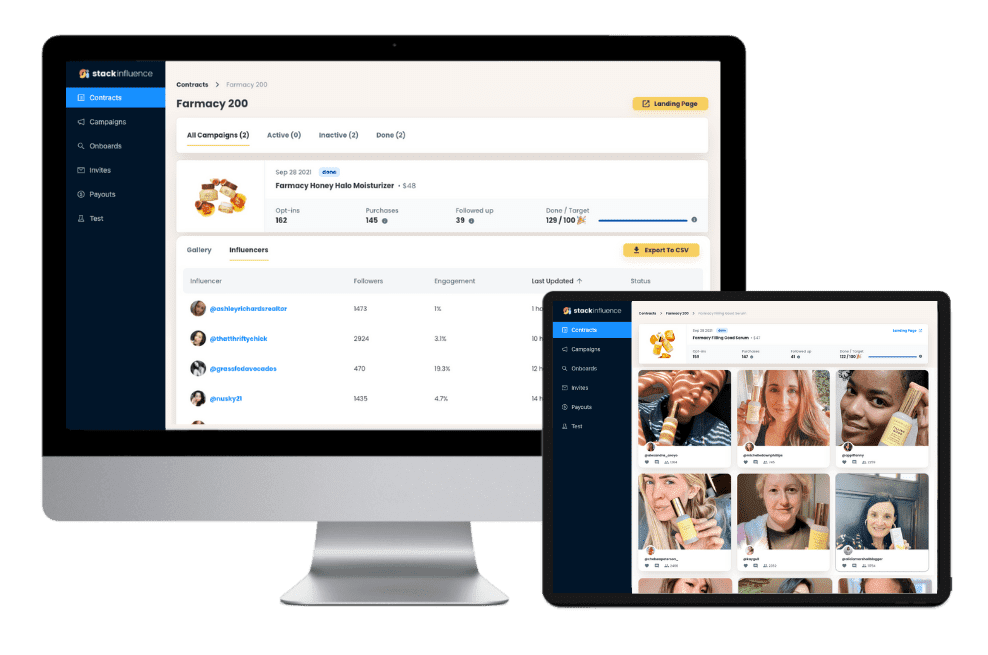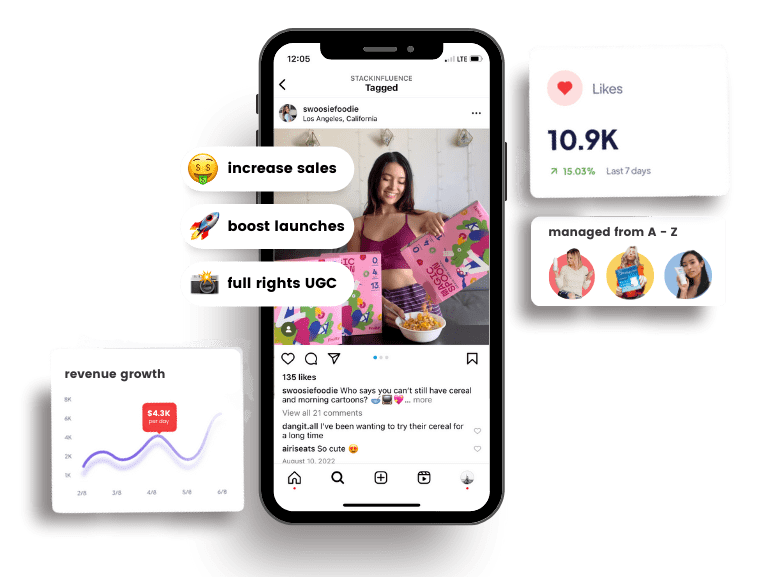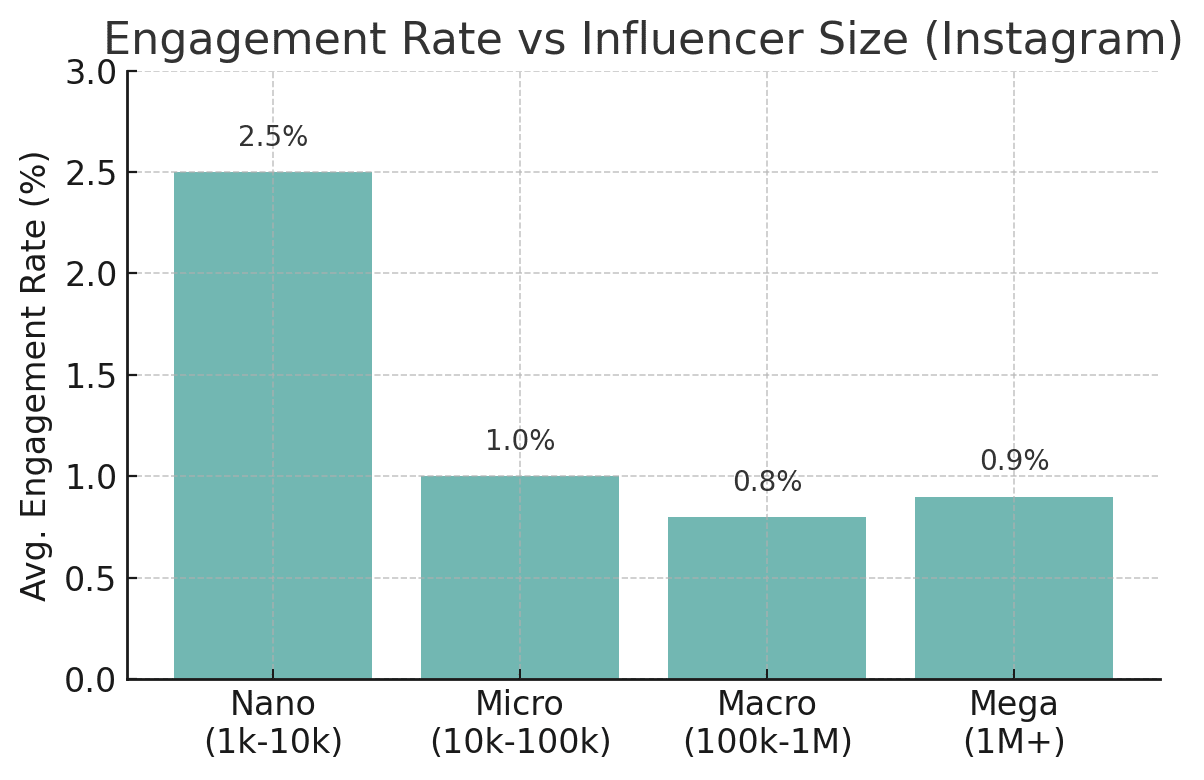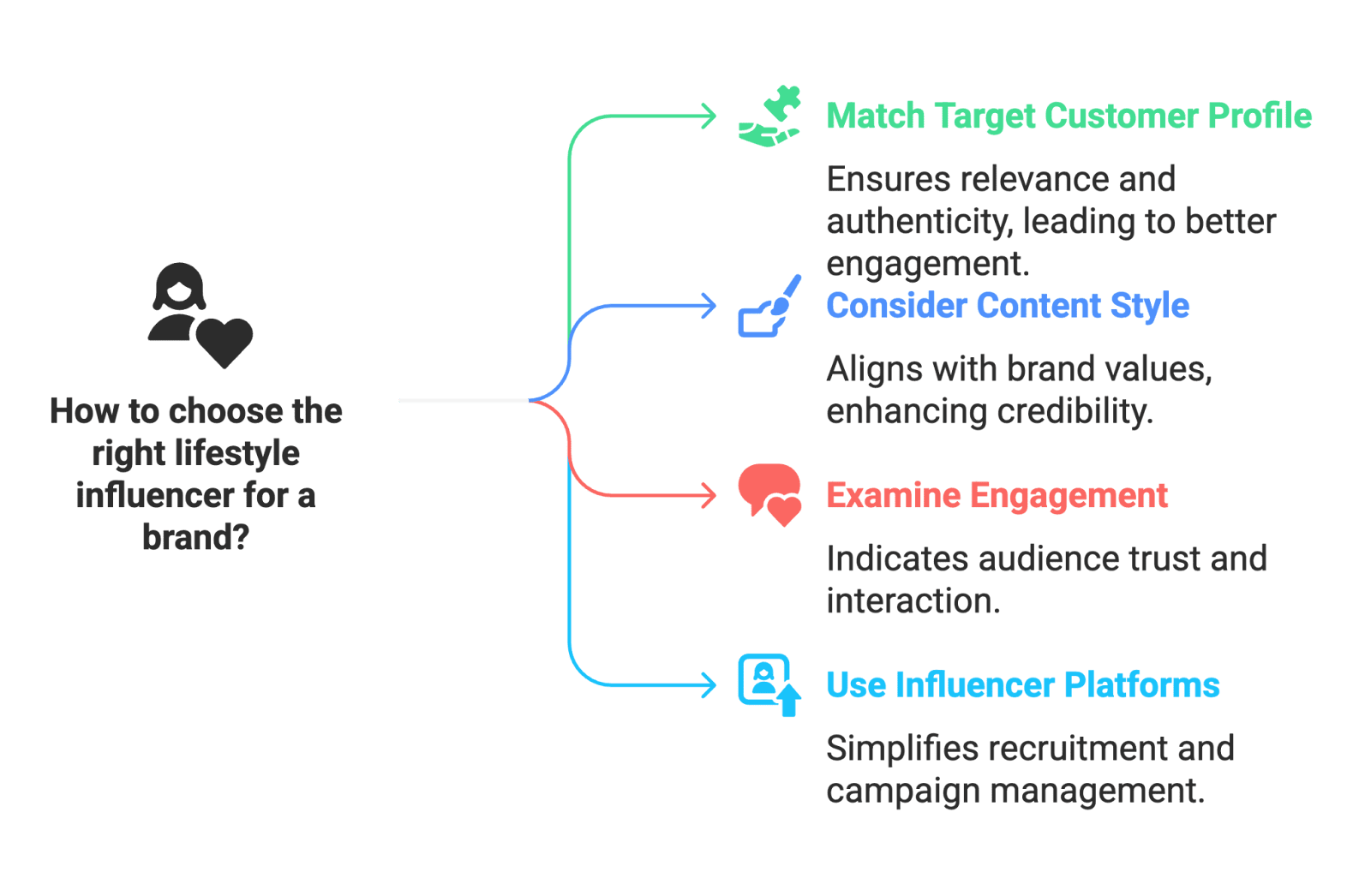What Are Lifestyle Influencers?
21st
July, 2025
Influencer Marketing
Amazon Marketplace
Artificial Intelligence
TikTok Tips
Collaborating with a lifestyle influencer can be a powerful way to expand your brand’s reach, connect with targeted audiences, and drive authentic engagement. But what exactly is a lifestyle influencer, and why are they so valuable to e-commerce brands and marketers today? In this post, we’ll break down what lifestyle influencers are, the different tiers (from nano to mega influencers), and the key benefits of working with them. We’ll also explore how lifestyle content creators can boost results for e-commerce companies (including Amazon sellers) by generating trusted recommendations and user-generated content (UGC). Let’s dive in and see why lifestyle influencers have become a must-have partnership in modern marketing.
A lifestyle influencer often shares relatable content about everyday life – from fashion and beauty tips to home decor hacks – engaging followers with their personal style and recommendations.
What Is a Lifestyle Influencer?
Lifestyle influencers are captivating online personalities who share and promote aspects of their daily life, interests, and values on social media. They build a following by creating content around niche lifestyle topics such as fashion, beauty, travel, fitness, food, home décor, or personal development. Essentially, their posts reflect their own lifestyle choices and passions – offering tips, tutorials, product reviews, and personal stories to connect with their audience. For example, a travel-loving influencer might chronicle their adventures and favorite gear, while a home décor enthusiast posts room makeovers and DIY ideas. Followers tune in for inspiration on how to elevate their own lives in those areas.
Lifestyle Influencer Categories: Like other influencers, lifestyle creators are often grouped by their follower count. Each tier has unique strengths depending on your goals:
-
Nano Lifestyle Influencers (1K–10K followers)
These are everyday creators with a small but highly engaged audience. Nanos typically focus on a very specific interest or community, allowing for intimate, personal interactions with followers. They may only reach a few thousand people, but those fans are often very loyal and responsive.
-
Micro Lifestyle Influencers (10K–100K followers)
Micro influencers have a bit wider reach while still maintaining strong community engagement. They are known for their authenticity and relatable content, often sharing personal stories or daily life hacks that resonate deeply with their niche audience. Micros hit a sweet spot – large enough to influence many people, but small enough to feel like a trusted friend rather than a celebrity.
-
Macro Lifestyle Influencers (100K–1M followers)
Macro influencers boast a broad reach and a more diverse audience. They’ve typically developed a recognizable personal brand or persona that many people know. A macro lifestyle influencer might be a prominent blogger or YouTuber whose style or expertise has mass appeal across demographics. They can introduce your brand to hundreds of thousands of people, though their content may be less niche-focused than nanos/micros.
-
Mega Lifestyle Influencers (1M+ followers)
The mega tier includes the true internet celebrities – often famous figures or top industry experts with immense followings. They wield significant influence due to their sheer reach. A mega lifestyle influencer’s post can make a huge splash, but these influencers are generally less personally interactive with fans compared to smaller creators. (Many mega influencers are household-name celebrities whose lifestyles set trends globally.)
Each type of lifestyle influencer can play a role in your marketing strategy. If you want niche credibility and community engagement, nanos and micros shine. For massive brand exposure, macros and megas can broadcast your message far and wide. Next, let’s look at why brands – especially e-commerce brands – are eager to work with lifestyle influencers at all levels.

Unlock the Power of Micro Influencers and Elevate your Brand Today!

Why Work with Lifestyle Influencers? (Key Benefits)
Lifestyle influencers aren’t just popular for fun – they offer real value to brands. By partnering with an influencer whose life and audience align with your product, you tap into a built-in fanbase that trusts that person’s recommendations. Here are some of the top benefits of working with lifestyle influencers in marketing:
-
Reach New Audiences
Lifestyle creators can introduce your brand to audiences you might not reach otherwise. Macro and mega influencers in particular have large, geographically dispersed followings, giving your brand exposure to new potential customers on a broad scale. For instance, a fashion influencer with 500K followers can instantly put your boutique in front of style enthusiasts worldwide. This expanded reach helps grow brand awareness beyond your current circle.
-
Build Brand Awareness and Credibility
When an influencer features your product as part of their lifestyle, it boosts your brand visibility and credibility by association. Their followers learn about your brand in a context that feels natural, not like an ad. Over time, seeing your name pop up in an influencer’s content builds recognition. Importantly, audiences tend to trust influencers like they trust friends – their personal vouch carries weight. In fact, 84% of consumers trust peer recommendations (like those from influencers) over traditional advertising. This trust can make your brand seem more authentic and credible. Lifestyle influencers essentially lend you social proof, saying “this product is part of my life and it’s great,” which resonates more than a corporate message.
-
Increase Engagement and Social Media Growth
Partnering with influencers can boost your own social media engagement and following. When a lifestyle influencer tags your brand or creates content around it, you’ll likely see an influx of likes, comments, and shares from their audience. Their stamp of approval makes people more inclined to interact with your brand. Your social posts might get more saves and comments, and your follower count can climb from the added exposure. Influencer collaborations also give you fresh content to repost on your channels (with permission), which further drives engagement. Overall, an active influencer campaign can be a catalyst that livens up your social media presence, creating a buzz that spills over to your profiles.
-
Affordable Content Creation (Bonus – UGC)
Another big perk is that lifestyle influencers double as content creators for your brand. The photos, videos, and stories they produce showcasing your product are essentially high-quality user-generated content. You can often repurpose this content in your own marketing – share their Instagram Reel on your feed, feature their YouTube review on your website, etc. This saves your team the time and cost of producing all content in-house. Micro and nano influencers, in particular, are known for creating authentic, relatable posts (sometimes with just a gifted product as compensation). Collaborating with a few lifestyle influencers can net you a library of real-life product images and testimonials to fuel your ads, emails, and product pages. It’s a cost-effective way to build a gallery of lifestyle-centric content around your brand.
As you can see, lifestyle influencers can impact every stage of the marketing funnel – from awareness and engagement to trust and conversion. No wonder 69% of consumers say they trust influencer recommendations over information directly from brands. By working with the right influencers, you essentially borrow that earned trust and goodwill to enhance your own brand marketing.
Micro-Influencers, E-Commerce and the Power of Niche Influence
While all types of lifestyle influencers have their place, many e-commerce brands and Amazon sellers are finding that smaller influencers (nano and micro) deliver outsized results for the investment. In the world of online retail, trust and authenticity are everything – especially when customers can’t touch or try your product in person. This is where micro lifestyle influencers shine. They may not have millions of followers, but their audience relationships are often tighter-knit and more persuasive. Let’s explore why micro influencers are a sweet spot for e-commerce, and how even large marketplaces like Amazon benefit from these partnerships.
Higher Engagement = More Trust and Action

One major advantage of nano/micro influencers is their high engagement rates. Their audiences are small communities of genuinely interested followers, so a much larger percentage of people actively like, comment, and click on their posts compared to huge celebrity accounts. For example, Instagram posts by nano-influencers (under ~5k followers) see about a 2.5% engagement rate on average, versus around 1% for micro-influencers with 10k+ followers. By contrast, mega influencers with millions of followers often see well under 1% engagement on posts.
Chart: Smaller lifestyle influencers tend to have significantly higher average engagement rates on Instagram than bigger influencers. Nano influencers (<10k followers) see around 2–3% engagement, versus under 1% for macro/mega influencers. This means nano/micro audiences are highly tuned-in – a recommendation from a small influencer can feel more genuine and spur more action from followers.
What does this higher engagement mean for e-commerce sellers? In short, greater trust and influence. When an influencer’s followers are frequently interacting and paying attention, they’re more likely to notice and trust that influencer’s product recommendations. It’s akin to a close friend suggesting something versus a distant celebrity hawking a product. In fact, one survey found 84% of consumers are “highly likely” to follow a micro-influencer’s product recommendation – an incredibly strong conversion potential. For Amazon sellers trying to earn customer trust (and reviews) on a crowded marketplace, that kind of influence is gold. A micro lifestyle influencer’s enthusiastic review of your kitchen gadget or skincare line can quickly translate into a bump in Amazon sales, as their loyal fans go check out the product themselves.
Better ROI and Cost-Effectiveness
Micro and nano influencers are also budget-friendly, which is crucial for many small businesses. Partnering with a big-name influencer or running traditional ad campaigns can cost tens of thousands of dollars. In contrast, micro influencers often charge only a few hundred dollars per post – and many nanos will collaborate in exchange for free product or affiliate commissions. This low cost, combined with the higher engagement we discussed, means you often get more sales per dollar spent with micros. One study found that nano/micro influencer campaigns can deliver about a 20:1 return on investment, whereas campaigns with macro influencers yielded roughly 6:1 ROI. That’s a huge difference in marketing efficiency. Essentially, micro influencers “punch above their weight,” delivering outsized results for less cost.
For example, instead of paying $20,000 for a single Instagram post by a mega influencer (which might get lost in a feed), that same budget could sponsor dozens of micro influencer posts. Those dozens of smaller posts would generate multiple pieces of content, reach several niche audiences, and likely produce more total engagement and conversions than the one celebrity post. It’s a classic case of quantity and quality (engagement) beating pure size. This is why savvy D2C and Amazon brands are scaling up micro-influencer programs – they see a better cost-per-conversion. And as a bonus, all the content those micros create becomes valuable UGC for the brand to repurpose.

Unlock the Power of Micro Influencers and Elevate your Brand Today!

E-Commerce Loves Influencers (and Vice Versa)
It’s no coincidence that over half of brands using influencer marketing are e-commerce businesses. Online sellers find influencer partnerships especially effective because social media drives shoppers directly to their digital storefronts. A lifestyle influencer’s post can seamlessly include a swipe-up link or bio link to your product page, making it easy for interested followers to shop immediately. With Amazon in particular, influencers often use affiliate links or Amazon storefronts to showcase products they love, turning their social feed into a direct sales funnel for Amazon listings.
In the ultra-competitive online market, lifestyle influencers also give e-commerce brands something that’s hard to buy – authentic social proof. Shoppers are skeptical of polished ads, but seeing a real person incorporate a product into their daily life is persuasive. Influencers basically generate word-of-mouth buzz at scale, which is marketing magic. (In fact, word-of-mouth drives more than twice the sales of paid advertising in general.) By partnering with a cluster of micro lifestyle influencers, an e-commerce brand can ignite many small “word-of-mouth” fires – through makeup tutorials, unboxing videos, stylish Instagram photos, blog mentions, you name it – creating a ripple effect of awareness and interest that traditional ads struggle to achieve.
Finding the Right Fit (Quality Matters)

To maximize success, it’s important to choose lifestyle influencers who closely match your target customer profile and brand values. Bigger isn’t always better – relevance and authenticity are key. Look for influencers whose content style and interests align with your product. For example, if you sell eco-friendly home goods, a sustainability-minded micro influencer who shares zero-waste living tips would likely outperform a random mega celeb with no connection to that niche. Examine an influencer’s engagement (do people reply to them?), the tone of their content, and how they present sponsored products. The best lifestyle influencers weave promotions into their storytelling in a genuine way. As a brand, you want to collaborate with creators who naturally resonate with your mission and aesthetic – this ensures the partnership comes off as credible to the audience.
It can be helpful to start with a few micro or nano influencers as a test, then scale up what works. Many e-commerce marketers use influencer discovery platforms or agencies to find good matches. Platforms like Stack Influence, for example, specialize in connecting brands with vetted micro-influencers and managing campaigns at scale. (Stack Influence is a leading micro-influencer marketing platform focused on the Amazon marketplace, helping sellers generate authentic UGC and traffic for their listings.) Leveraging such services or tools can simplify the process of recruiting influencers, shipping out products for review, and tracking results, especially if you’re coordinating dozens or hundreds of micro collaborations.
Conclusion to What Are Lifestyle Influencers?
In a time when consumers crave authenticity, lifestyle influencers have emerged as invaluable partners for brands. They bridge the gap between brands and real people’s everyday lives. By sharing products they genuinely enjoy as part of their own lifestyle, these influencers create a trusted link to audiences that traditional advertising simply can’t replicate. Whether it’s a nano influencer on Instagram giving an unfiltered review of a kitchen gadget, or a famous lifestyle YouTuber vlogging about their daily wellness routine (featuring your supplement), the impact is similar – followers feel like they’re getting a recommendation from a friend, not a salesperson.
For marketers and e-commerce entrepreneurs, working with lifestyle content creators is an opportunity to humanize your brand and tap into enthusiastic communities. You can boost your brand awareness, gain new customers, and gather a wealth of social proof and content along the way. The data speaks for itself: most consumers trust influencers’ recommendations, and nearly every shopper has been influenced to purchase by social media at some point. By incorporating lifestyle influencers into your strategy, you meet your customers where they already are – scrolling Instagram, watching TikToks, reading blogs – and you do so with a message delivered by someone they already trust. That’s a recipe for marketing success in 2025 and beyond.
In summary, what are lifestyle influencers? They are relatable content creators who built communities around living life in a certain way – and in doing so, they’ve become powerful voices that can amplify your brand message. Whether you engage a dozen micro influencers to promote your new Amazon product, or partner with a single macro influencer for a big campaign, remember that authenticity and relevance are the north stars. Choose influencers who genuinely love what you offer and let them creatively share that love. The results can be trend-setting and profit-boosting. So, embrace these digital trendsetters and let lifestyle influencers help take your brand’s story to the next level in a truly authentic fashion. Your future customers are out there, following and listening – make sure your brand is part of the lifestyle conversation!

By William Gasner
CMO at Stack Influence
William Gasner is the CMO of Stack Influence, he's a 6X founder, a 7-Figure eCommerce seller, and has been featured in leading publications like Forbes, Business Insider, and Wired for his thoughts on the influencer marketing and eCommerce industries.
Want new articles before they get published? Subscribe to our Awesome Newsletter.
stack up your influence
turning creativity into currency
our headquarters
111 NE 1st St, Miami, FL 33132
our contact info
[email protected]
stack up your influence
turning creativity into currency
our headquarters
111 NE 1st St, 8th Floor
Miami, FL 33132


